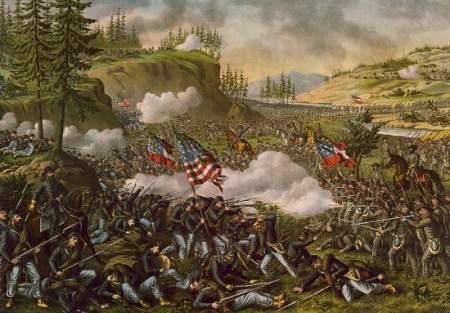
|
U. S. CIVIL WAR
PHOTOGRAPHS
|

|
CHICKAMAUGA
(PAGE 1 OF 6)
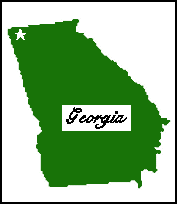 In the text, the icon
In the text, the icon  is a link to the definition of the word it marks. is a link to the definition of the word it marks.
Use your browser's "back" button to return to the page.
Battle of Chickamauga--Sept. 19' & 20' 1863.
Federal (Gen. Rosecrans com.) Confederate (Gen. Bragg com.)
Kurz & Allison, Art Publishers, Chicago, U.S.A., [1890]
| |
September 18-20, 1863
Estimated Casualties : 34,624
total (US 16,170; CS 18,454) : 34,624
total (US 16,170; CS 18,454)
After the Tullahoma Campaign, Union Major General William S. Rosecrans renewed
his offensive, aiming to force the Confederates out of Chattanooga. The three
army corps comprising
Rosecrans' army comprising
Rosecrans' army split and set
out for Chattanooga by separate routes. In early September, Rosecrans
consolidated his forces scattered in Tennessee and Georgia and forced
Confederate General Braxton Bragg's army out of Chattanooga, heading south. The
Union troops followed it and brushed with it at Davis' Cross Roads. split and set
out for Chattanooga by separate routes. In early September, Rosecrans
consolidated his forces scattered in Tennessee and Georgia and forced
Confederate General Braxton Bragg's army out of Chattanooga, heading south. The
Union troops followed it and brushed with it at Davis' Cross Roads.
Bragg was determined to reoccupy Chattanooga and decided to meet a part of
Rosecrans' army, defeat them, and then move back into the city. On the 17th he
headed north, intending to meet and beat the U.S. XXI Army Corps. On the morning
of the 18th three Confederate brigades of Lt. General James Longstreet's corps
arrived, under General John B. Hood's command. As Bragg marched north, his
cavalry and infantry fought with Union cavalry and mounted infantry. of Lt. General James Longstreet's corps
arrived, under General John B. Hood's command. As Bragg marched north, his
cavalry and infantry fought with Union cavalry and mounted infantry.
On the morning of September 19, 1863, fighting began in earnest, and Bragg's men
hammered but did not break the Union line. This brought on an all-day battle in
which neither side gained any decided advantage.
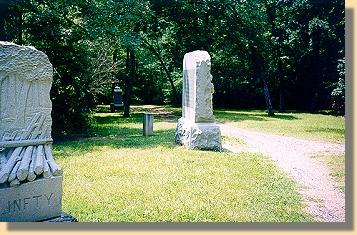
Union Major General George H. Thomas's Initial Battle Line.
During the night the two opposing forces further rearranged their dispositions in
the difficult terrain. Rosecrans prepared defensive positions, and Bragg planned
an attack. Longstreet arrived during the night with two more brigades and was
given command of the left wing of Bragg's army.
On September 20, 1863, Bragg continued his assault on the Union line on the left.
About 9:30 a.m., Confederates under Lt. Gen. Leonidas Polk attacked Union Major
Gen. George H. Thomas corps causing Rosecrans to shift troops to Thomas's aid.
Shortly before 11 a.m., Rosecrans was informed that he had a gap in his line.
Rosecrans's misunderstanding as to the true location of his units led him to
strengthen the defenses on his right while Thomas held the other flank . Thinking that Brig. Gen. Thomas J. Wood
was on Maj. Gen. Joseph J. Reynolds's right flank, he ordered Wood "to close up
and support Reynolds." Actually, Brig. Gen. John M. Brannan was on Wood's left,
not Reynolds, and following his instructions, Wood pulled out of the line, and
fell in on Reynolds's flank. . Thinking that Brig. Gen. Thomas J. Wood
was on Maj. Gen. Joseph J. Reynolds's right flank, he ordered Wood "to close up
and support Reynolds." Actually, Brig. Gen. John M. Brannan was on Wood's left,
not Reynolds, and following his instructions, Wood pulled out of the line, and
fell in on Reynolds's flank.
In moving units to shore up the supposed gap, Rosencrans had created one.
Apparently by coincidence, Longstreet hit the precise point left open by the
Federals, crossing over the field by the Brotherton cabin and driving one-third
of the Union army, including Rosecrans himself, from the battle.
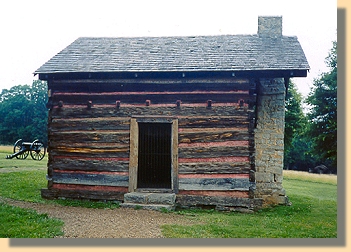
Brotherton Cabin
The Brotherton Cabin, pictured above, is a post war structure next to the
wartime site.
At the time of the battle of Chickamauga, George and Mary Brotherton and
their children lived in a log house at this location. In the surrounding
fields they grazed cattle and grew corn and hay. To escape the battle, some
of the Brothertons and other local families took refuge in a ravine about a
mile from here. There they endured hunger and cold, and prayed for their
boys serving in the Confederate army.
Tom Brotherton, one of the sons, played a key role in the battle. Because
Tom "knew every pig trail through these woods," General Longstreet,
commander of the Confederate left wing, employed him as a scout. Tom
served with pride, telling his brother Jim, "It's a sorry lad that won't
fight for his own home." Jim Brotherton also fought for the South.
After the battle, Adaline Brotherton, the youngest daughter, returned to
the cabin in search of food. Finding four or their cows who had
miraculously survived the battle, she prepared milk for the refugee
families. However, the hundreds of wounded Union and Confederate soldiers
she saw there aroused her sympathy, and she gave the milk to them.
(Text Source: U.S. Gov't, National Park Service)
|
NATIONAL PARK SERVICE INTERPRETIVE SIGN
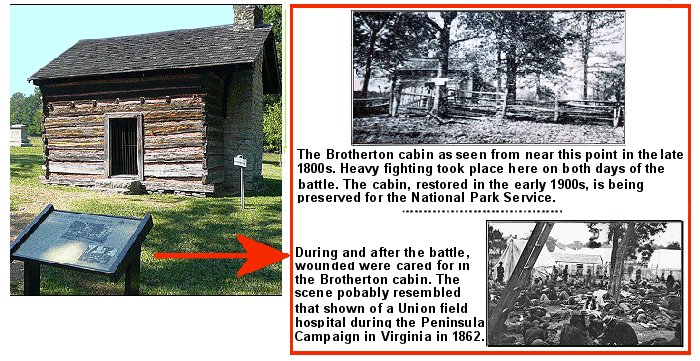
The National Park Service Sign at the Brotherton Cabin contains a
photograph
of the Union Field Hospital at
Savages Station, Virginia,
a result of the June 27, 1862
Gaines Mill battle.
As a result of Longstreet's breakthrough, Major General William S. Rosecrans,
Maj. Gen. Alexander McCook, and Maj. Gen. Thomas L. Crittenden fled to
Chattanooga, thinking the entire army was being
destroyed. However, Union Maj. Gen. George H. Thomas, "The Rock of Chickamauga",
and his troops remained and held at Snodgrass Field until after dark.
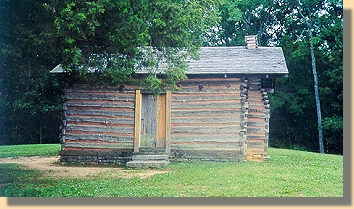
Snodgrass House
Then, on orders from Rosecrans, they withdrew. The Union retired to Chattanooga
while the Confederates encircled them by occupying the surrounding heights.
(Source: Various, including The National Park Service, and "The Civil War
Dictionary", by Mark M. Boatner III).
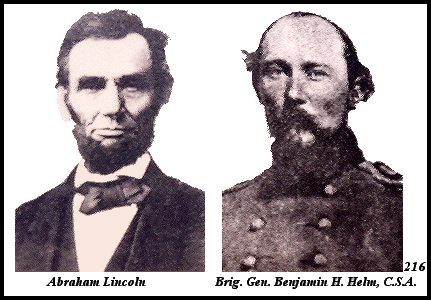
C.S.A. Brigadier General Benjamin H. Helm, the brother-in-law of President
Abraham Lincoln was mortally wounded on the morning of September 20, 1863. Helm
had been leading his Kentuckians against the Union breastworks when a bullet
pierced his right side. He died that night. when a bullet
pierced his right side. He died that night.
President Lincoln had offered Helms, a West Point graduate, a commission in the
Union Army, but Helm joined the Confederate Army instead. When President
Lincoln learned his favored brother-in-law had been killed at Chickamauga, he
was visibly stricken. It is said that Helm's death hurt Lincoln as much as the
death of his son Willie, stricken with fever in 1862.
(Source: N.P.S. Interpretive Sign at Chickamauga.)
|
|
PAGE TWO
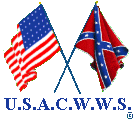 >
Civil War Photos
>
Western Map
>
Chickamauga
>
Page 2
>
3
>
4
>
5
>
6
>
Civil War Photos
>
Western Map
>
Chickamauga
>
Page 2
>
3
>
4
>
5
>
6
Notes
|
|





